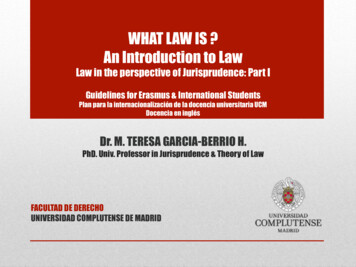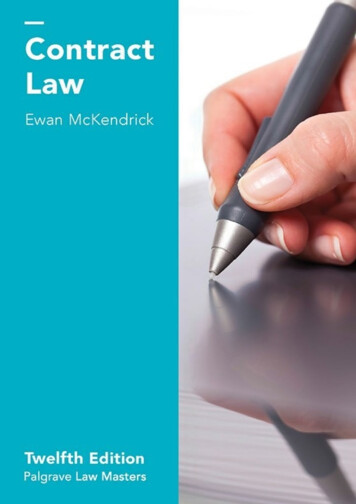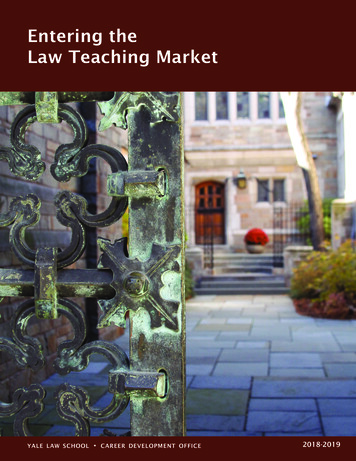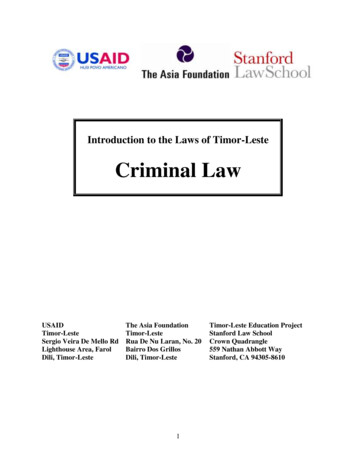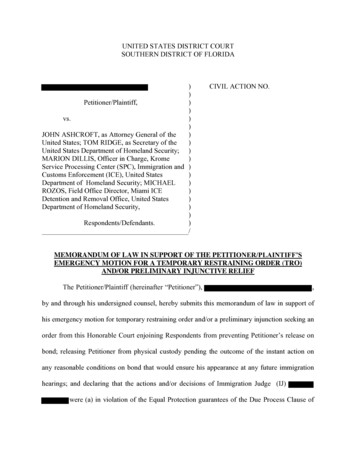
Transcription
UNITED STATES DISTRICT COURTSOUTHERN DISTRICT OF FLORIDA))Petitioner/Plaintiff,))vs.))JOHN ASHCROFT, as Attorney General of the)United States; TOM RIDGE, as Secretary of the)United States Department of Homeland Security; )MARION DILLIS, Officer in Charge, Krome)Service Processing Center (SPC), Immigration and )Customs Enforcement (ICE), United States)Department of Homeland Security; MICHAEL)ROZOS, Field Office Director, Miami ICE)Detention and Removal Office, United States)Department of Homeland Security,))Respondents/Defendants.)/CIVIL ACTION NO.MEMORANDUM OF LAW IN SUPPORT OF THE PETITIONER/PLAINTIFF’SEMERGENCY MOTION FOR A TEMPORARY RESTRAINING ORDER (TRO)AND/OR PRELIMINARY INJUNCTIVE RELIEFThe Petitioner/Plaintiff (hereinafter “Petitioner”),,by and through his undersigned counsel, hereby submits this memorandum of law in support ofhis emergency motion for temporary restraining order and/or a preliminary injunction seeking anorder from this Honorable Court enjoining Respondents from preventing Petitioner’s release onbond; releasing Petitioner from physical custody pending the outcome of the instant action onany reasonable conditions on bond that would ensure his appearance at any future immigrationhearings; and declaring that the actions and/or decisions of Immigration Judge (IJ)were (a) in violation of the Equal Protection guarantees of the Due Process Clause of
the Fifth Amendment by utilizing the impermissible criteria of national origin as a basis to denybond; (b) in violation of the substantive and procedural guarantees of the Due Process Clause ofthe Fifth Amendment by determining that no conditions of bond, except financial conditions,could be set and therefore no conditions of bond could satisfy release; and (c) in violation of theImmigration and Nationality Act (INA) and U.S. Department of Justice (DOJ) regulationsbecause an IJ does have the authority to set non-monetary conditions of bond in a removalproceeding. To avoid redundancy, Petitioner hereby incorporates the factual background and theprocedural history of his case as set forth in the instant motion and makes reference to thesupporting exhibits attached to the Petition for Writ of Habeas Corpus Pursuant to 28 U.S.C. §2241 and Complaint for Declaratory and Injunctive Relief (hereinafter “Habeas Petition”).ARGUMENTI.JURISDICTIONA.Subject Matter JurisdictionThis Court has subject-matter jurisdiction over the instant petition and action under 28U.S.C. § 2241(c)(1) and (3), Art. I, § 9, C1. 2 of the United States Constitution (“SuspensionClause”), and 28 U.S.C. § 1331, as Petitioner is in the custody of the United States Departmentof Homeland Security (“DHS”), acting under the color of authority, by Respondents, agents ofthe United States.Despite the provisions of INA § 236(e), codified at 8 U.S.C. § 1226(e), which bar federalcourts from reviewing discretionary decisions regarding parole and bond “under this section,” itis well-settled that INA § 236(e) does not serve to bar federal courts from reviewing questions ofstatutory construction or Constitutional claims such as mandatory detention under the statutory2
writ of habeas corpus, 28 U.S.C. §2241. See Demore v. Kim, 123 S.Ct. 1708, 1713-14 (2003)(INA §236(e) does not bar habeas jurisdiction in absence of specific provision barring habeasand because petitioner lodged a constitutional challenge to legislation); Zadvydas v. Davis, 533U.S. 678, 686-89, 121 S.Ct. 2491, 2497-98 (2001) (INA 236(e), 242(a)(2)(B)(ii), 242(a)(2)(C),242(g) did not bar habeas jurisdiction for challenge to post-removal detention); Haitian RefugeeCtr., Inc. v. Nelson, 872 F.2d 1555, 1560 n. 9 (11th Cir. 1989) (holding that federal courts alsohave jurisdiction to review allegations that agency officials have acted outside their statutoryauthority); Gonzalez v. O’Connell, 355 F.3d 1010, 1014-15 (7th Cir. XXXX) (Habeasjurisdiction to challenge mandatory detention even where the predicate issue to the constitutionalclaim was a statutory claim); Aguilar v. Lewis, 50 F. Supp.2d 539, 542-43 (E.D. Va. 1999) (INA§236(e) bars discretionary decisions not statutory interpretation); Velasquez v. Reno, 37 F.Supp.2d 663, 667-70 (D.N.J. 1999) (INA §236(e) barring review of detention decisions does notforeclose habeas challenge to application of statute).Moreover, INA §242(g) does not barreview of detention decisions; nor does INA §242(b)(9) or INA §242(a)(2)(B)(ii). Zhislin v.Reno, 195 F.3d 810 (6th Cir. 1999) (INA § 242(g) as interpreted by Reno v. American- ArabAnti-Discrimination Comm., 119 S.Ct. 936, 943 (1999) does not bar review of challenge toindefinite detention); Parra v. Perryman, 172 F.3d 954 (7th Cir. 1999) (In light of AmericanArab INA §242(g) does not bar habeas to review detention issue);Sillah v. Davis, 252 F.Supp.2d 589, 593-97 (W.D. Tenn. 2003) (INA §242(a)(2)(B)(ii) does not preclude habeasjurisdiction to challenge revocation of parole); Bouayad v. Holmes, 74 F. Supp.2d 471, 473-74(E.D. Pa. 1999) (Government conceded that habeas jurisdiction existed to challenge mandatorydetention and the court determined that neither INA § 236(e) nor INA § 242(b)(9) precludejurisdiction over detention); Kiareldeen v. Reno, 71 F. Supp.2d 402, 405-07 (D. N.J. 1999)3
(Neither INA § 236(e) nor § 242(g) bars habeas jurisdiction to review detention based uponsecret evidence); Alikhani v. Fasano, 70 F. Supp.2d 1124, 1126-30 (S.D. Cal. 1999) (INA§§242(g), 242(b)(9) and 236(e) do not bar challenge to statutory and constitutional challenge tomandatory detention).In INS v. St. Cyr, 533 U.S. 289, 302 (2001), the Supreme Court held that habeas is stillavailable to challenge the legality of the Service’s deportation and removal orders because theConstitution requires habeas review to extend to claims of erroneous application or interpretationof statutes. See Calcano-Martinez v. I.N.S., 533 U.S. 338 (2001) (holding that aliens may bringtheir statutory and constitutional claims in district court by filing a habeas petition although suchclaims brought in petitions for review with courts of appeals would be dismissed for lack ofjurisdiction); Bejacmar v. Ashcroft, 291 F.3d 735, 736 (11th Cir. 2002) (abandoning its reasoningin Richardson v. Reno, 180 F.3d 1311 (11th Cir. 1998), cert. denied, 120 S.Ct. 1529 (2000), andfinding that “St. Cyr removes the last statutory pillar supporting our circuit’s earlier conclusionthat IIRIRA repealed district court jurisdiction in habeas cases”)Similarly, in Zadvydas v. Davis, 533 U.S. 678, 694-97, 121 S.Ct. 2491 2501-02 (2001),resident alienswho had been ordered removed brought habeas petitions challenging theirdetention during a period of custody beyond the 90-day removal period.In that case, theSupreme Court stated as follows regarding habeas jurisdiction: “We note at the outset that theprimary federal habeas corpus statute, 28 U.S.C. § 2241, confers jurisdiction upon the federalcourts to hear these cases.” Id. at 687 (citing Section 2241(c)(3), authorizing any person to claimin federal court that he or she is being held “in custody in violation of the Constitution or laws. .of the United States”).With respect to the alien’s important Constitutional claims, the Courtfound that4
[a] statute permitting indefinite detention of an alien would raise a seriousconstitutional problem. The Fifth Amendment's Due Process Clause forbids theGovernment to "depriv[e]" any person . . . of . . . liberty . . . without due processof law." Freedom from imprisonment--from government custody, detention, orother forms of physical restraint--lies at the heart of the liberty that Clauseprotects. See Foucha v. Louisiana, 504 U.S. 71, 80, 112 S.Ct. 1780, 118 L.Ed.2d437 (1992). And this Court has said that government detention violates thatclause unless the detention is ordered in a criminal proceeding with adequateprocedural protections, see United States v. Salerno, 481 U.S. 739, 746, 107 S.Ct.2095, 95 L.Ed.2d 697 (1987), or, in certain special and "narrow" nonpunitive"circumstances," Foucha, supra, at 80, 112 S.Ct. 1780, where a specialjustification, such as harm-threatening mental illness, outweighs the "individual'sconstitutionally protected interest in avoiding physical restraint." Kansas v.Hendricks, 521 U.S. 346, 356, 117 S.Ct. 2072, 138 L.Ed.2d 501 (1997). Theproceedings at issue here are civil, not criminal, and we assume that they arenonpunitive in purpose and effect. There is no sufficiently strong specialjustification here for indefinite civil detention--at least as administered under thisstatute.Id. at 690 (emphasis added).Here, Petitioner challenges: (1) the use of Petitioner’s Mexican nationality as a basis todeny his liberty in violation of the equal protection guarantees of the Due Process Clause of theFifth Amendment;and (2) the IJ’s erroneous application and misinterpretation of theImmigration and Nationality Act (“INA”), Section 236(a), codified at 8 U.S.C. §1226(a), as wellas implementing federal regulations, viz., 8 C.F.R. §1003.19, 8 C.F.R. § 1236.1(d), whichresulted in the IJ’s denial of Petitioner’s request for release on bond. The IJ’s order denyingrelease on bond subjected the Petitioner to detention pending the actual execution of his removal,based solely on his national origin and despite the fact that Petitioner has absolutely no criminalrecord in the United States, and in fact has never committed nor ever been accused of anycriminal acts in this country. The only charge in his Notice to Appear (NTA) issued November19, XXXX, the charging document issued by the U.S. Department of Homeland Security, agentsof Respondents, concerned Petitioner’s inadvertent overstay of his H1-B status.See HabeasPetition, ¶ 11; see also Exh. 3 attached to Habeas Petition. Moreover, as will be discussed, Mr.5
is not required to exhaust his administrative remedies in this case. Therefore, thisCourt has subject matter jurisdiction over Petitioner’s habeas claims which are now ripe forreview.B.Exhaustion of Administrative Remedies Is Not Required in This Case“Of ‘paramount importance’ to any exhaustion inquiry is congressional intent. WhereCongress specifically mandates, exhaustion is required.But where Congress has not clearlyrequired exhaustion, sound judicial discretion governs.” McCarthy v. Madigan, 503 U.S. 140,144, 112 S.Ct. 1081 (1992); Haitian Refugee Ctr., Inc. v. Nelson, 872 F.2d 1555, 1561 (11th Cir.1989) (“We note at the outset that the application of the judicial exhaustion doctrine is subject tothe discretion of the trial court.”) (citing Panola Land Buyers Ass'n v. Shuman, 762 F.2d 1550,1556-57 (11th Cir. 1985); Haitian Refugee Center v. Smith, 676 F.2d 1023, 1034 (5th Cir. 1982)(“the exhaustion requirement is not a jurisdictional prerequisite but a matter committed to thesound discretion of the trial court”). Here, Congress has not specifically mandated exhaustionbefore judicial review of custody determinations. Because exhaustion is not required by statute,sound judicial discretion must govern this Court’s decision of whether to exercise jurisdictionabsent exhaustion. See McCarthy, 503 U.S. at 144. Exercise of such sound judicial discretion iswarranted here because there is an abundant body of law that supports this Court’s jurisdictionover this case absent exhaustion.First, exhaustion does not apply where, as here, a petition challenges only the agencyaction collateral to removal proceedings, such as bond. Welch v. Reno, 101 F.Supp.2d 347, 351(D. Md. 2000) (Statutory exhaustion only for review of final orders of removal); Aguilar v.Lewis, 50 F.Supp.2d 539, 541 (E.D. Va. 1999) (No federal statute imposes an exhaustion6
requirement concerning bond); Rowe v. INS, 45 F. Supp. 2d 144, 145-46 (D. Mass. 1999) (andcases cited therein); Pastor-Camarena v. Smith, 977 F. Supp. 1415, 1417 (W.D. Wash. 1997)(and cases cited therein); Montero v. Cobb, 937 F. Supp. 88, 90-91 (D. Mass. 1976). Alikhani v.Fasano, 70 F.Supp.2d 1124, 1129- 30 (S.D. Cal. 1999). The instant petition only seeks reviewof the IJ’s bond determination, and not of a final order of removal.In addition, exhaustion is not required “where [, as here,] an agency’s exercise ofauthority is clearly at odds with the specific language of the statute.” McClendon v. JacksonTelevision Inc., 603 F.2d 1174, 1177 (5th Cir. 1979). As discussed infra, the IJ’s exercise ofauthority to deny Petitioner release on bond solely on the ground that the IJ has no statutoryauthority to impose bond conditions other than monetary conditions directly contravenes thespecific language of § 236(a), which confers the IJ such authority.Moreover, exhaustion is also not required where a review procedure exists but it is notmandated by statute or agency regulations. Darby v. Cisneros, 113 S.Ct. 2539 (1993) (Whereregulation provided that ALJ’s determination shall be final unless the Sec. of HUD, in hisdiscretion, decides to review the decision after request of a party, such regulation does notprovide for mandatory review and plaintiff could file suit without making request to Sec.);Noriega-Lopez v. Ashcroft, 335 F.3d 874, 880-82 (9th Cir. 2003) (Failure to file a motion toreconsider BIA decision is neither statutorily required under INA §242(d)(1) nor prudentiallyrequired); Chang v. U.S., 327 F.3d 911, 922- 24 (9th Cir. 2003) (Where investor was notrequired to seek a removal proceeding to review denied petition and where IJ in removal couldnot address APA, estoppel and constitutional claims and where statutes now limit the scope ofremoval proceedings, plaintiffs did not have to exhaust removal proceeding). Here, althoughPetitioner may appeal the IJ’s decision to the BIA, such appeal is not mandated by statute or7
agency regulations. See 8 C.F.R. § 1003.19(f) (“An appeal from the determination by anImmigration Judge may be taken to the Board of Immigration Appeals pursuant to § 1003.38”)(emphasis added).Finally, exhaustion of administrative remedies would be futile in this case because theBIA has no jurisdiction to adjudicate constitutional issues raised here.1See Mathews v.Eldridge, 424 U.S. 319, 328-30 (1976) (A constitutional challenge to administrative actiondoes not require exhaustion.); Jean v. Nelson, 727 F.2d 957, 981 (11th Cir. 1984) (en banc),aff’d, 472 U.S. 846, 105 S.Ct. 2992 (1985) (allowing exception to exhaustion requirement whereremaining administrative remedies could not cure alleged defect in agency procedures); RamirezOsorio v. INS, 745 F.2d 937, 939 (5th Cir. 1984) (holding that “exhaustion is not required whenadministrative remedies are inadequate”); Haitian Refugee Center v. Smith, 676 F.2d 1023,1033-36 (5th Cir. 1982) (same). Some courts have held that, notwithstanding the constitutionalclaims, exhaustion is still required if the claims involve a procedural error that is correctable bythe administrative tribunal. Vargas v. INS, 831 F.2d 906, 908 (9th Cir. 1987); Dhangu v. INS,812 F.2d 455, 460 (9th Cir.1987). Nonetheless, exhaustion is not required here since the BIAhas no expertise to adjudicate the equal protection claim raised in the instant case.SeeGarberding v. INS, 30 F.3d 1187, 1188 n.1 (9th Cir. 1994) (Although a party may be required to1It should be noted that the instant case is distinguishable from Boz v. United States, 248 F.3d 1299 (11thCir. 2001), wherein the Eleventh Circuit affirmed the district court’s dismissal of a habeas petition for lack ofjurisdiction on the ground that the petitioner failed to exhausted the administrative remedies available to him.However, Boz does not apply here because that case involved the post-removal mandatory detention of criminalaliens under INA § 236(c) and § 241, where administrative remedies were available to the petitioner, 90-days afterissuance of his final order of removal. To the contrary, the instant case involves pre-removal non-mandatorydetention of a non-criminal alien under INA § 236(a). Here, the Petitioner “need not exhaust his administrativeremedies” because the only available administrative remedy, appeal to the BIA, would be futile as it “will notprovide relief commensurate with the claim” raised in the instant case. Haitian Refugee Ctr., Inc. v. Nelson, 872F.2d 1555, 1561 (11th Cir. 1989). In addition, the continuing validity of Boz is in doubt in light of Zadvydas v.Davis, 533 U.S. 678, 701, 121 S.Ct. 2491 (2001). Subsequent to Boz, the Supreme Court in Zadvydas held thatdetention of permanent resident aliens beyond six months following issuance of an alien’s final order of removal ispresumptively unreasonable. Zadvydas, 533 U.S at 701-02. In Boz, the petitioner had been held in post-removaldetention for approximately three (3) years. Boz, 248 F.3d at 1300.8
exhaust a procedural due process claim that could be remedied by the IJ, an equal protectionclaim that the IJ/BIA cannot decide does not require exhaustion); Jankowski v. INS, 138F.Supp.2d 269, 273-76 (D. Conn. 2001) rev’d on other grounds 291 F.3d 172 (2d Cir. 2002)(Equal protection challenge does not require exhaustion).C. This Court’s Authority to Grant the Instant MotionThis Court has the discretion to enter a temporary restraining order and a preliminaryinjunction. See Haitian Refugee Center v. Nelson, 872 F.2d 1555, 1561-1562 (11th Cir. 1989).In order for preliminary relief to issue, the movant must establish the following: (1) a substantiallikelihood that the movants will ultimately prevail on the merits; (2) that he will sufferirreparable injury if the injunction is not issued; (3) that the threatened injury to the movantoutweighs the potential harm to the opposing party; and (4) that the injunction, if issued, wouldnot be adverse to the public interest. Id. As discussed below, all of these factors heavily weighin the Petitioner’s favor in the instant case.II.Substantial Likelihood that the Petitioner will Prevail on the Merits Of His ClaimsA.Statutory Violation of INA § 236(a)1.Standard of Statutory ConstructionWhen reviewing an agency’s interpretation of a statute, the Court must apply establishedcanons of statutory construction. I.N.S. v. Cardoza-Fonseca, 480 U.S. 421, 431, 107 S.Ct. 1207,94 L.Ed.2d 434 (1987). The words used are to be given their ordinary meaning, Chevron v.Natural Resources Defense Council, Inc., 467 U.S. 837, 104 S.Ct. 2778 (1984), and the languagein question is to be construed in harmony with related provisions and the statute as a whole. KMart Corp. v. Cartier Inc., 486 U.S. 281, 291, 108 S.Ct. 1811, 100 L.Ed.2d 313 (1988).Furthermore, the language should not be construed in a way that renders a term surplusage.9
United States v. Menasche, 348 U.S. 528, 75 S.Ct. 513, 99 L.Ed. 615 (1955). If the languageregarding intent is ambiguous, the Court must defer to the agency’s reasonable interpretation ofthe statute. Chevron, 467 U.S. at 843. If the language of the statute is not ambiguous, the intentof Congress must be given effect. Hughes Aircraft Co. v. Jacobson, 525 U.S. 432, 438, 119S.Ct. 755, 142 L.Ed.2d 881 (1999); Chevron, U.S.A., 467 U.S. 837 at 842-43, 104 S.Ct. 2778, 81L.Ed.2d 694. An agency’s interpretation may be overturned only if it is arbitrary, capricious, ormanifestly contrary to law. Chevron, U.S.A., 467 U.S. at 842-43, 104 S.Ct. 2778. However, thefederal courts should defer to an agency decision only when the statute, “applying the normal‘tools of statutory construction,’ [is] ambiguous.” INS v. St. Cyr, 533 U.S. 289, 320 n. 45, 121S.Ct. 2271 (internal citations omitted).2.Section 236(a) clearly authorizes the IJ to “prescribe” and imposebond conditions he deems appropriateApplying these standards, it is clear that § 236(a) authorizes the IJ to “prescribe” andimpose bond conditions he deems appropriate. Under § 236(a)(2), the Attorney General (and hisdesignate the immigration judge) “may release the alien on—(A) bond of at least 1,500, withsecurity approved by, and containing conditions prescribed by, the Attorney General . . .(emphasis added). The plain language of the statute, therefore, authorizes the IJ to “prescribe”and impose conditions for bond. Under the statute, the only limit imposed on the IJ’s authority isgranting work authorization to Mr.as a condition of release.INA §236(a)(3).Therefore, giving the words of the statute their ordinary meaning, as required, Chevron, 467 U.S.837, § 236(a) authorizes the IJ to impose bond conditions he deems appropriate. Federal caselaw interpreting § 236(a) in the context of the IJ’s authority to impose bond conditions alsosupports Petitioner’s construction of the statute. Petitioner’s research reveals only three federaldistrict court cases that interpreted § 236(a) in that context. All of these cases clearly indicate10
that, when determining release on bond under § 236(a), the IJ has statutory authority to imposeany conditions he/she deems appropriate. Quezada-Bucio v. Ridge, 317 F.Supp.2d 1221 (W.D.Wash. XXXX) (“The IJ would then determine, based on the standard set forth in INA § 236(a),whether, and under what conditions, petitioner may be released from custody pending theresolution of his appeal before the BIA”) (emphasis added). Alwaday v. Beebe, 43 F.Supp.2d1130 (D. Or. 1999) (same); Pastor-Camarena v. Smith, 977 F. Supp. 1415, 1418 (W.D. Wash.1997) (same).3.Companion Regulations to § 236(a) also authorize the IJ to impose bondconditions he deems appropriateNor do the regulations of the Department of Justice prohibit the IJ from setting otherconditions of bond. 8 C.F.R. §1003.19 (XXXX); 8 C.F.R. § 1236.1(d). In fact, 8 C.F.R. §1236.1(d) provides that the IJ may impose conditions other than monetary condition. Thisregulatory provision provides that:After an initial custody determination by the district director,including the setting of a bond, the respondent may, at any timebefore an order under 8 CFR part 1240 becomes final, requestamelioration of the conditions under which he or she may bereleased. (emphasis added). Prior to such final order . . . theimmigration judge is authorized to exercise the authority in section236 of the Act . . . to detain the alien in custody, release the alien,and determine the amount of bond, if any, under which therespondent may be released, as provided in § 1003.19 of thischapter. If the alien has been released from custody, an applicationfor amelioration of the terms of release must be filed within 7 daysof release.This regulatory provision provides that an alien in removal proceedings may seekreconsideration of the Service’s initial custody determination before an IJ at any time before afinal order of removal is issued against him, including amelioration of conditions of his release.It further provides that such alien may seek amelioration of the terms of release even after he is11
released. This by implication means that the IJ has authority to impose various conditions of hisrelease before a final order of removal is issued.In addition, the regulatory provision provides that the IJ has authority under INA § 236 torelease the alien, and determine the amount of bond, if any, under which the respondent may bereleased, as provided in § 1003.19 of this chapter. As indicated previously, § 236 only prohibitsthe IJ from granting work authorization to Mr.as a condition of release, and authorizesthe IJ to “prescribe” and impose conditions for bond. INA §236(a)(2)(A). Nor does 8 C.F.R.§1003.19 prohibit the IJ from setting other conditions of bond. Therefore, reading “in harmony”these “related” statutory and regulatory provisions “as a whole,” as required, K Mart, 486 U.S. at291, the only logical conclusion that can be drawn is that the IJ has authority under INA §236(a)to “prescribe and impose” any conditions for bond he deems necessary. Reading the statuteotherwise would render the terms of the statute surplusage, see Menasche, supra, contraveningthe intent of Congress in enacting the statute.4.The IJ’s decision directly contravenes § 236(a) and its companion regulationsThe IJ’s bond determination in the instant case was arbitrary, capricious, and manifestlycontrary to law, because it directly contradicts the plain meaning of § 236(a) and companionregulations, which authorize him to consider conditions other than monetary condition for bond.Chevron, U.S.A., 467 U.S. at 842-43, 104 S.Ct. 2778 (An agency’s interpretation may beoverturned only if it is arbitrary, capricious, or manifestly contrary to law.).The IJimpermissibly concluded that he had no statutory authority to impose any conditions of bond,other than financial conditions, that would ensure Mr.other conditions suggested by Mr. Xensure Mr.appearance. Ignoring all thethe IJ reasoned that financial conditions would not’ appearance, because as a Mexican citizen he could obtain a birth certificate12
and cross the border. See Habeas Petition, ¶ 20; see also Declaration Under Penalty of Perjuryofattached as Exh. 8 to Habeas Petition (hereinafterrefferred to as “Decl.”), ¶¶ 10-11. As discussed, supra, the IJ’s claim that he couldnot impose any other conditions, such as electronic monitoring, extensive reporting, or orderingMr.to provide his passports to ICE, and therefore could not guarantee his appearance,is in clear contravention of INA §236(a)(2)(A), 8 U.S.C. §1226(a)(2)(A), and its companionregulations.B.The IJ Violated Petitioner’s Equal Protection Rights Under the FifthAmendment to the United States ConstitutionAt the hearing, the IJ denied Petitioner’s release on bond, specifically on the basis of hisMexican citizenship. According to the IJ, because Petitioner is a citizen of Mexico he may notbe released on bond because he “could use his Mexican birth certificate to cross the border intoMexico” and, therefore, again according to the IJ, this makes Petitioner a “flight risk” and noteligible for release. However on the basis of this faulty and speculative reasoning, any alien ofMexican nationality before any immigration judge in the future could be disabled from beingreleased on bond, merely on the basis of his Mexican national origin.Such a result isdiscriminatory and plainly unconstitutional, as will be discussed. It is clear that the IJ’s decisionto deny release on bond on such a basis was in contravention of equal protection and due processclause contained in the Fifth Amendment to the United States Constitution.It is well-settled that equal protection applies to aliens who are physically present in, andadmitted to, the United States to the same scope and extent as United States citizens. Yick Wo v.Hopkins, 118 U.S. 356, 369 (1886) (holding that the protections of the Constitution “areuniversal in their application to all persons within the territorial jurisdiction, without regard to13
any differences of race, of color or of nationality”); Plyler v. Doe, 457 U.S. 202, 211-12, 102S.Ct. 2382, 2391-92, (1982) (the Fifth, Sixth, and Fourteenth Amendments apply to all personswithin the United States, including excludable aliens); Korematsu v. U.S., 323 U.S. 214, 216(1944) (applying strict scrutiny to incarceration of Japanese in United States during World WarII);Bolling v. Sharpe, 347 U.S. 497 (1954) (applying strict scrutiny to race discrimination inschools in Washington, D.C.); Castaneda v. Partida, 430 U.S. 482 (1977); Hernandez v. Texas,347 U.S. 475 (1954) (holding that national origin discrimination against Hispanics in grand juryselection impermissible); Oyama v. California, 332 U.S. 633, 644-47 (1948) (holding thatrestriction on transfer of agricultural property of Japanese lawful permanent resident is aviolation of equal protection).The Supreme Court in Zadvydas v. Davis, discussed supra, underscored in that decisionthe importance of constitutional rights attaching to aliens within the borders of the United States.As the Court clearly stated, “[t]he distinction between an alien who has effected an entry into theUnited States and one who has never entered runs throughout immigration law. . . It is wellestablished that certain constitutional protections available to persons inside the United States areunavailable to aliens outside of our geographic borders. Zadvydas, 533 U.S. at 693 (citing UnitedStates v. Verdugo-Urquidez, 494 U.S. 259, 269, 110 S.Ct. 1056, 108 L.Ed.2d 222 (1990) (FifthAmendment's protections do not extend to aliens outside the territorial boundaries); Johnson v.Eisentrager, 339 U.S. 763, 784, 70 S.Ct. 936, 94 L.Ed. 1255 (1950) (same). The Court madeclear however that “once an alien enters the country, the legal circumstance changes, for the DueProcess Clause applies to all “persons” within the United States, including aliens, whether theirpresence here is lawful, unlawful, temporary, or permanent. Id. (citing Plyler v. Doe, 457 U.S.202, 210, 102 S.Ct. 2382 (1982); Mathews v. Diaz, 426 U.S. 67, 77, 96 S.Ct. 1883 (1976);14
Kwong Hai Chew v. Colding, 344 U.S. 590, 596-598, and n. 5, 73 S.Ct. 472, 97 L.Ed. 576(1953); Yick Wo v. Hopkins, supra).Petitioner has been admitted to the United States since 1999, and thereforeunquestionably enjoys the full protection of the Equal Protection Clause under the case law citedabove. See Habeas Petition, ¶ 10; Decl. ¶ 1. Mr. Xin his Notice of Removal, issued November 19,only charge of removal appearingis that he failed to maintain or complywith the conditions of his change of status, in violation of INA § 237(a)(1)(C)(i). See HabeasPetition, Exh. 3. The reason for his overstay was inadvertent, see Habeas Petition, ¶ 12; Decl.¶ 4, as Mr.was laid-off from his professional position and was given faulty advice byprior counsel that he had six months to depart the United States after his lay-off.Id.Mr.had never previously violated any immigration laws of the United States and has neverknowingly violated or even been accused of violating any other laws of the United States,immigration or criminal, before his arrest and incarceration without bond. Id.Because the IJ’s decision rested on a “suspect classification,” namely Petitioner’snational origin as a Mexican citizen, it is wel
MEMORANDUM OF LAW IN SUPPORT OF THE PETITIONER/PLAINTIFF'S EMERGENCY MOTION FOR A TEMPORARY RESTRAINING ORDER (TRO) AND/OR PRELIMINARY INJUNCTIVE RELIEF The Petitioner/Plaintiff (hereinafter "Petitioner"), , by and through his undersigned counsel, hereby submits this memorandum of law in support of




